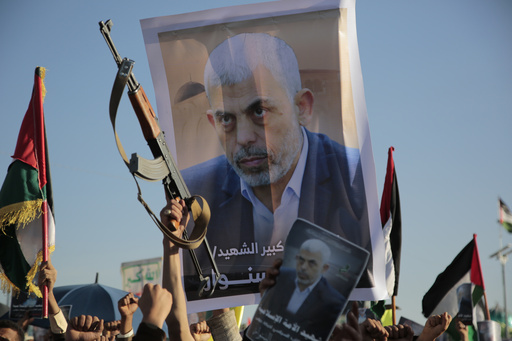The last known sight of Yahya Sinwar, the leader of Hamas, was a stark reminder of the ongoing conflict in the region. In a ruined Palestinian home, footage showed him wounded and cornered as he confronted an Israeli drone, even throwing a stick in defiance. For Israel, this imagery symbolized triumph, portraying Sinwar, the mastermind behind the October 7 attacks, in a state of defeat. However, across the Arab and Muslim worlds, the narrative diverged, with many viewing him as a resolute martyr who fought bravely until the end.
The drone footage swiftly spread across social media, prompting discussions that included quotes from Sinwar himself, where he expressed a willingness to die in battle. An oil painting of a masked Sinwar sitting confidently in an armchair also gained popularity, seemingly capturing the essence of his last moments. Egyptian journalist Osama Gaweesh suggested that the broadcast of Sinwar’s final moments transformed him into a figure larger than life, one whose legacy outlasted that of those who sought to kill him.
Reactions to Sinwar’s death varied widely within Gaza. Some mourned him deeply, while others felt a sense of hope that his demise could possibly pave the way for peace following the devastation unleashed by his directives during the humanitarian crisis. Opinions among the Arab and Muslim populace were equally divided. Nevertheless, there was a consensus among supporters and some critics that Sinwar’s last stand was noble, contrasting sharply with narratives claiming he had been hiding in tunnels throughout the conflict.
Israel’s military responded to the situation by distributing leaflets that displayed an image of Sinwar deceased, asserting he was responsible for much suffering and challenging claims of bravery. Analysts noted Sinwar’s death was distinct from other regional leaders, as he appeared to confront adversaries rather than being caught in secrecy in an underground location. This view was echoed by Sadeq Abu Amer of the Palestinian Dialogue Group, who highlighted the uniqueness of Sinwar’s situation.
Iran, a significant ally of Hamas, framed Sinwar’s death as a powerful counter-narrative to the downfall of former Iraqi President Saddam Hussein, emphasizing that Sinwar faced his adversaries openly and courageously. Additionally, Al-Azhar, a leading Sunni Islamic institution, criticized Israel’s framing of Sinwar, emphasizing the nobility of those they call “martyrs of the resistance.”
In Israel, the news of Sinwar’s death was greeted with celebrations, both publicly and online. Video footage captured jubilant scenes in Tel Aviv, where beachgoers applauded the announcement, while soldiers distributed sweets in celebration. However, this festivity was juxtaposed against protests from families of hostages held by Hamas, who urged Israeli leadership to capitalize on this moment to secure their loved ones’ return.
Contrarily, Palestinian author Susan Abulhawa remarked that the imagery of Sinwar’s demise served to inspire and unify many instead of inducing despair, as Israel intended. For some Palestinians, including those displaced by conflict, Sinwar was honored as a fighter who stood firm. Others, particularly in places like Khan Younis, his hometown, participated in unique funeral rituals that symbolically honored his legacy despite the absence of his body.
In Lebanon, despite varying opinions on Sinwar, many viewed his passing as emblematic of courageous resistance, while some Palestinians expressed cynicism toward his leadership. Abu Amer suggested that ultimatums surrounding Sinwar’s life and death will not significantly alter the broader Arab public perception related to the events of October 7 and the subsequent fallout. Individuals remain polarized, as many continue to focus on the humanitarian implications of the ongoing conflict rather than offering outright support for Sinwar’s actions and legacy.
